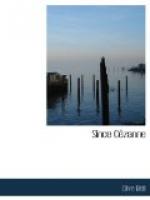Almost everyone would admit that, considered as pictures, those great decorations in the Doges’ Palace were a little empty; no one can deny that as parts of a vast scheme they are superbly adequate. Very much the same might be said of the decorations I have in mind. It is clear that Friesz plotted and reasoned with himself until he had contrived a method of matching means with ends. By constructing it out of forms less charged, more fluent, and more in the nature of arabesques than those he habitually employs he gave to his scheme continuity and easy comprehensibility: but never did he allow those forms to subside into mere coloured spaces, or the lines to become mere flourishes: always every detail was doing something, and so the whole was significant and alive. The scheme which was planned with caution was carried through with passion.
Now, obviously, a painter capable of performing this feat must possess a rare, at this moment possibly unique, gift. Friesz is one who can bring the whole weight of his intellect to bear on his sensibility. That sensibility let no one underrate. Before his vision of the external world, especially before what we are pleased to call Nature, Friesz has a reaction as delicate and enthusiastic as that of an English poet. Only, unlike most English painters, he would never dream of jotting it down and leaving it at that. Such hit-or-miss frivolity is not in his way. He is no amateur. He takes his impressions home and elaborates them; he brings his intellect to bear on them; and, as this exhibition shows, without robbing them of their bloom, makes of them something solid and satisfying. To realize what a power this is we may, I hope without indiscretion, glance for an instant at another handsomely endowed French painter. That M. Lhote does not want for sensibility is shown by his sketches and water-colours, that his intellect is sharp enough is proved by his writings; but the devitalized rectitude of his more ambitious pieces shows how appallingly difficult it is to bring intellect to bear on sensibility without crushing it. The failure of M. Lhote is the measure of M. Friesz’s achievement.
If I am right, it is only natural that pictures by Friesz should improve on acquaintance. The studied logic of the composition may for a time absorb the spectator’s attention and blind him to more endearing qualities; but, sooner or later, he will begin to perceive not only that a scrupulously honest vision has been converted into a well-knit design, but that the stitches are lovely. In every part he will be discovering subtle and seductive harmonies and balances of which the delicacy dawns on him as he gazes. The more he looks the more will he get of that curiously gratifying thrill which comes of the recognition of unostentatious rightness.




